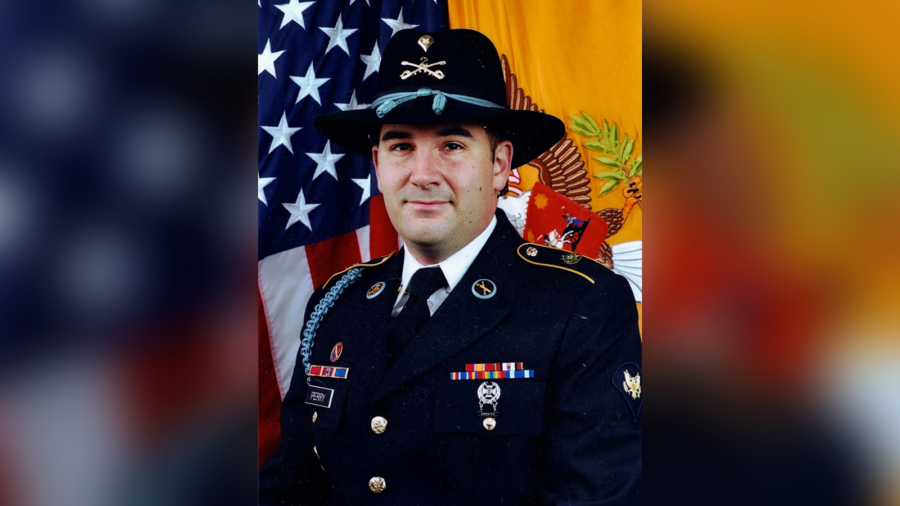Attorneys for Daniel Perry, a U.S. Army sergeant, filed a motion for a new trial days after Perry was convicted of murder. The legal team said key evidence was omitted from Perry’s trial that showed he acted in self-defense and that the jury was subject to “outside influence.”
Perry, 37, had fatally shot Garrett Foster, who had approached Perry’s car with a rifle during a Black Lives Matter demonstration, in Austin, on July 25, 2020. Perry, who was working for Uber, was traveling to Austin for work at the time before his car was surrounded by protesters, one of whom was Foster.
During his trial, Perry’s legal team said he had shot Foster in self-defense, only after Foster raised his rifle. Meanwhile, prosecutors alleged that Perry had provoked the shooting by driving into the crowd of protesters that night.
The jury found Perry guilty of murder on April 7.
Court ‘Excluded Key Evidence’
In the 26-page motion Tuesday, the lawyers said a new trial is needed because the court had “erroneously excluded key evidence” from the jury about Foster and the other protesters. The evidence showed that Foster was the “first aggressor” and that Perry had faced “multiple assailants” when his car was surrounded, they said.
For example, Perry’s attorneys attempted to introduce evidence—which included photos, videos, and testimonies—of three incidents that they said showed Foster had, in previous incidents, unlawfully tried to intimidate cars on public streets.
Perry’s lawyers also repeatedly tried to introduce into evidence a video recording of Foster, taken by a protester witness on the morning of July 25, 2020. The video showed that when Foster was asked if he felt like he’d need to use his AK-47, he said: “Na. I think the uh—I mean if I use it against the cops, I’m dead. I think all the people that hate us, and you know, wanna say [expletive] to us are too big of a [expletive] to stop and actually do anything about it.”
According to Perry’s attorneys, the evidence showed that Foster and fellow protesters “routinely harassed vehicles that attempted to interfere with their efforts to ‘take the streets.'”
“[T]hese incidents show that Mr. Foster and his fellow protestors were not the intimidatees when dealing with cars on the public streets, but, rather, they were the intimidators.
“In other words, the protestors did not swarm Sgt. Perry’s car because they were intimidated by Sgt. Perry’s car, but rather to intimidate Sgt. Perry just like they attempted to intimidate [other motorists.] Likewise, the excluded evidence would have helped show that Foster did not approach Sgt. Perry’s car to protect his fellow protestors, but rather, approached Sgt. Perry to attempt to intimidate him just like he [previously] attempted to intimidate [other motorists].”
The excluded evidence would have also shown that the protest that night was not peaceful, unlike the “impression left by several protestor witnesses” that the protest was typical of other protests in which Foster and others “allegedly always acted peacefully, Perry’s lawyers stated.
Court Didn’t Let Defense Include Police Report
Attorneys also argued in the motion that the court had “erred by not allowing the defense to introduce the police report into evidence.”
The police report of more than 900 pages showed that the homicide detective, Joe Fugitt, concluded after a lengthy investigation that Perry “had the right to be on the public roadway” and that he “did not provoke an armed encounter with Garrett Foster or engage in criminal activity other than a traffic violation [ran a red light],” and “reasonably acted in self-defense.”
“Sgt. Perry was denied the opportunity to have jurors review the report and determine for themselves what was missing and what was included,” Perry’s lawyers said.
‘Outside Influence’ Affected Jury
Perry’s defense team also argued the motion for a new trial should be granted because “a juror conducted his own internet research” and shared what he found with the other jurors, which meant that the jury was subject to “outside influence.”
Specifically, the juror researched the Texas Penal Code, and Perry’s attorneys say that based on the research, the other jurors “would have been left with a completely wrong view of the law of self-defense as it relates to the burden of proof.”
Separately, attorneys for Perry also noted that an alternate juror participated in jury deliberations by making noises such as “snort, huff, gasp” to express her displeasure with comments made by other jurors that “were inconsistent with finding Mr. Perry guilty.”
Perry’s lawyers noted that while new trial motions are normally filed after sentencing, “defense counsel believed it was important to bring the ‘outside influence’ facts to the Court’s attention as soon as they were learned.”
From The Epoch Times

